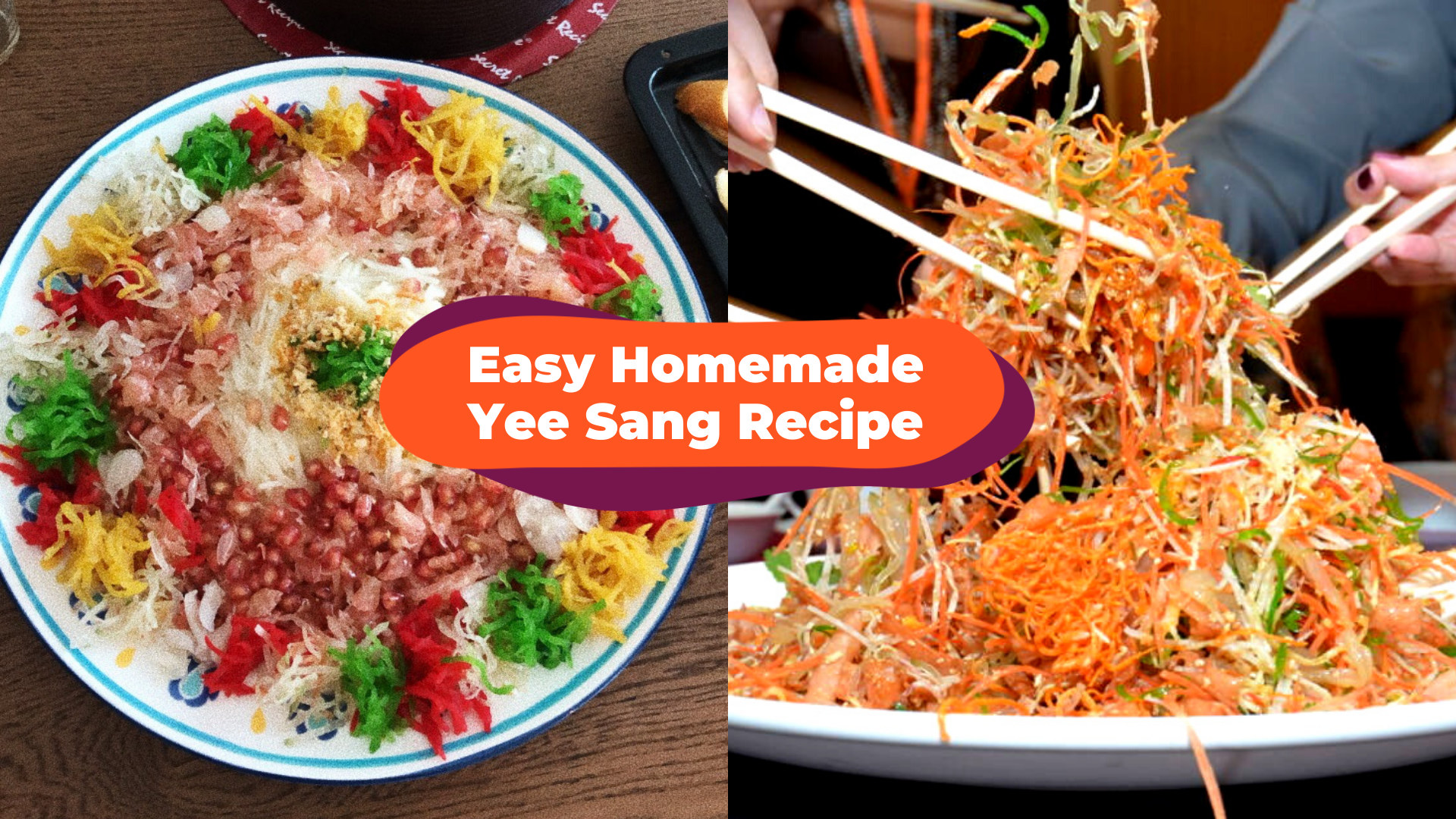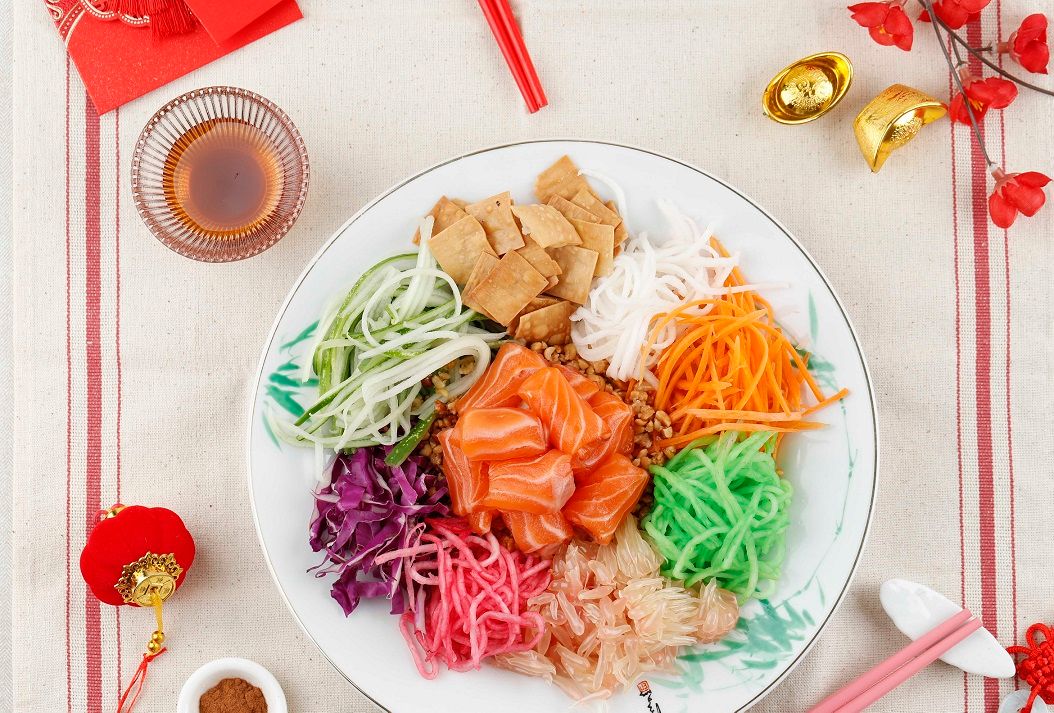As the vibrant hues of Chinese New Year approach, the delectable tradition of lou sang takes center stage. This vibrant salad, laden with auspicious ingredients and steeped in cultural symbolism, is a culinary masterpiece that brings families and friends together to celebrate the arrival of the Lunar New Year.
In this comprehensive guide, we delve into the art of crafting a homemade lou sang, exploring its ingredients, symbolism, preparation techniques, and cultural significance. Whether you’re a seasoned pro or a novice in the kitchen, this guide will empower you to create a delectable and meaningful lou sang that will delight your taste buds and honor the traditions of this beloved festival.
Introduction
Unveiling the culinary masterpiece of Chinese New Year, Lou Sang, a vibrant salad brimming with symbolism and prosperity. This traditional dish holds a special place in the hearts of many, representing the harmonious blending of cultures and the joyous celebration of new beginnings.
Originating in Southeast Asia, Lou Sang has evolved into a symbol of unity and good fortune. Its colorful ingredients, each representing different aspects of life, are tossed together with well wishes for the coming year.
Significance of Lou Sang
Lou Sang is not just a salad; it is a symbol of prosperity and good fortune. The tossing of the salad is believed to bring good luck and abundance. The higher the toss, the greater the fortune.
- Prosperity: The raw fish symbolizes wealth and abundance.
- Good Health: The shredded vegetables represent longevity and good health.
- Fertility: The pomelo symbolizes fertility and abundance.
- Sweetness: The sweet plum sauce represents a sweet and prosperous life.
Ingredients and their Significance
Lou sang, a traditional Chinese New Year dish, is a vibrant and symbolic salad that represents prosperity, abundance, and good fortune. Each ingredient in lou sang holds a specific significance, contributing to the overall meaning and festive spirit of the dish.
The following table lists the essential ingredients of a homemade lou sang recipe, along with their respective meanings:
| Ingredient | Significance |
|---|---|
| Raw Fish (Salmon or Tuna) | Abundance and prosperity |
| Shredded Carrots | Good luck and wealth |
| White Radish | Purity and cleansing |
| Pickled Green Ginger | Youthfulness and vitality |
| Spring Onions | Intelligence and cleverness |
| Sesame Seeds | Fertility and prosperity |
| Crushed Peanuts | Longevity and health |
| Crispy Prawn Crackers | Gold and wealth |
| Plum Sauce | Prosperity and sweetness |
| Pomegranate Seeds | Fertility and abundance |
Step-by-Step s

Creating a homemade lou sang is a delightful culinary experience that can be enjoyed with family and friends. Here are the detailed steps to guide you through the process:
Gathering the Ingredients
Before you begin, ensure you have all the necessary ingredients. Refer to the “Ingredients and their Significance” section for the complete list.
Preparing the Base
- Start by laying out a large serving platter.
- Spread a layer of shredded lettuce as the base.
- Top with shredded carrots, white radish, and cucumber.
- Arrange these ingredients evenly, creating a colorful and vibrant foundation.
Adding the Proteins
- Scatter cooked and shredded chicken or pork over the base.
- Add slices of smoked salmon or thinly sliced abalone for a luxurious touch.
- Top with crispy fried fish skin or crackers for a textural contrast.
Incorporating the Sauces and Toppings
- Drizzle a mixture of plum sauce, hoisin sauce, and sesame oil over the ingredients.
- Sprinkle chopped peanuts, sesame seeds, and fried shallots for added crunch and flavor.
- Top with a dollop of shredded ginger and chili for a touch of heat.
Mixing and Serving
Using a pair of chopsticks, mix all the ingredients thoroughly.
Serve immediately and enjoy the vibrant flavors and textures of your homemade lou sang.
Presentation and Serving
Traditionally, lou sang is served on a large platter, symbolizing abundance and prosperity. The ingredients are arranged in a colorful and auspicious manner, with each component representing a different aspect of good fortune.
In modern interpretations, lou sang can be presented in a variety of creative ways. Some chefs opt for individual portions, arranged in small bowls or ramekins. Others create elaborate centerpieces, using edible flowers and decorative elements to enhance the visual appeal.
The Symbolism of Tossing
The act of tossing lou sang is an integral part of the tradition. It symbolizes the mixing of different ingredients and cultures, as well as the collective aspiration for a prosperous and harmonious new year.
As the lou sang is tossed, it is customary to shout out auspicious phrases and well wishes. This is believed to bring good luck and fortune to all who participate.
Variations and Adaptations
Lou sang, a symbol of prosperity and abundance, is not confined to a single recipe. Variations and adaptations abound, catering to diverse tastes and dietary needs.
Classic Recipe Variations
The classic lou sang recipe allows for variations in the choice of raw fish. Salmon, tuna, or yellowtail are popular alternatives to the traditional yee sang fish. The addition of fruits like mango, pineapple, or pomelo adds a refreshing twist, while nuts like almonds or walnuts enhance the crunch factor.
Dietary Adaptations
Lou sang can be adapted to suit dietary restrictions. For vegetarians, tofu or mock fish can substitute the raw fish. Gluten-free soy sauce and rice crackers can accommodate those with gluten intolerance.
Innovative Interpretations
Creative chefs have taken lou sang to new heights with innovative interpretations. Molecular gastronomy techniques, such as spherification, have been used to create unique textures and flavors. Fusion dishes, combining elements from different cuisines, have also emerged, such as the sushi lou sang, featuring raw fish and Japanese-style ingredients.
Nutritional Value and Health Benefits
Lou sang is a nutrient-rich dish that offers various health benefits. It is packed with vitamins, minerals, antioxidants, and dietary fiber.
Vitamin and Mineral Content
Lou sang contains a range of vitamins and minerals, including:
-
-*Vitamin A
Supports eye health, immune function, and skin health.
-*Vitamin C
A potent antioxidant that boosts immunity and collagen production.
-*Vitamin E
Protects cells from oxidative damage and supports cognitive function.
-*Iron
Essential for red blood cell production and oxygen transport.
-*Calcium
Strengthens bones and teeth.
Antioxidant Properties
Lou sang is rich in antioxidants, such as flavonoids and carotenoids. These compounds protect the body from free radical damage, which can contribute to chronic diseases like cancer and heart disease.
Dietary Fiber
The various vegetables in lou sang provide dietary fiber, which supports digestive health, promotes satiety, and lowers cholesterol levels.
Potential Allergens and Dietary Considerations
While lou sang is generally safe for consumption, it is important to consider potential allergens and dietary considerations:
-
-*Seafood allergies
Lou sang often includes raw fish or seafood, which can trigger allergic reactions in sensitive individuals.
-*Gluten intolerance
If using soy sauce or teriyaki sauce, ensure they are gluten-free to accommodate those with gluten intolerance.
-*Vegan or vegetarian diets
Substitute the fish or seafood with tofu or tempeh to create a plant-based version of lou sang.
Cultural Significance and Symbolism
Lou sang holds immense cultural significance in Chinese tradition, particularly during Chinese New Year celebrations.
It symbolizes abundance, prosperity, and good fortune.
The act of tossing the lou sang together represents the collective aspiration for a prosperous year ahead. Each ingredient carries specific symbolic meanings, such as:
Fish
- Abundance and surplus
- The Chinese word for “fish” (yú) sounds similar to “abundance” (yú), representing a wish for financial abundance.
Pomelo
- Good luck and prosperity
- The Cantonese word for “pomelo” (yòu) sounds similar to “have” (yòu), symbolizing the wish to “have everything.”
Conclusion


Lou sang is a significant dish in Chinese culture, embodying prosperity and good fortune. Its preparation and consumption during the Chinese New Year symbolize unity, abundance, and the hope for a prosperous year ahead.
Reiterating the Importance of Lou Sang
Lou sang represents the collective spirit of the Chinese community, emphasizing the importance of family, tradition, and well-being. It serves as a reminder of the cultural heritage and the values that bind Chinese people together.
Encouraging Readers to Make Their Own Lou Sang
Making lou sang at home is a meaningful way to connect with Chinese culture and traditions. It is a fun and interactive activity that can be enjoyed by people of all ages. We encourage you to try your hand at preparing this symbolic dish and experience its cultural significance firsthand.
Conclusion


As you embark on your homemade lou sang journey, remember that this dish is more than just a culinary creation; it is a symbol of prosperity, abundance, and the enduring bonds that unite us. By embracing the traditions and symbolism associated with lou sang, you not only create a delicious dish but also contribute to the rich cultural tapestry of Chinese New Year celebrations.
May your homemade lou sang bring joy, prosperity, and an abundance of good fortune to your family and friends. Happy Chinese New Year!
FAQ Summary
Q: What is the significance of the tossing ritual associated with lou sang?
A: The tossing of lou sang symbolizes the tossing away of bad luck and misfortune and the welcoming of good fortune and prosperity in the coming year.
Q: Are there any variations to the classic lou sang recipe?
A: Yes, there are many variations of lou sang, including vegetarian and vegan versions, as well as adaptations to suit different dietary restrictions and preferences.
Q: What are the health benefits of consuming lou sang?
A: Lou sang is a nutritious dish packed with fresh vegetables, fruits, and nuts, providing a good source of vitamins, minerals, and antioxidants.
Q: How do I store leftover lou sang?
A: Leftover lou sang should be stored in an airtight container in the refrigerator for up to 2 days.
Q: Can I make lou sang ahead of time?
A: Yes, you can prepare the ingredients for lou sang ahead of time and assemble it just before serving.
